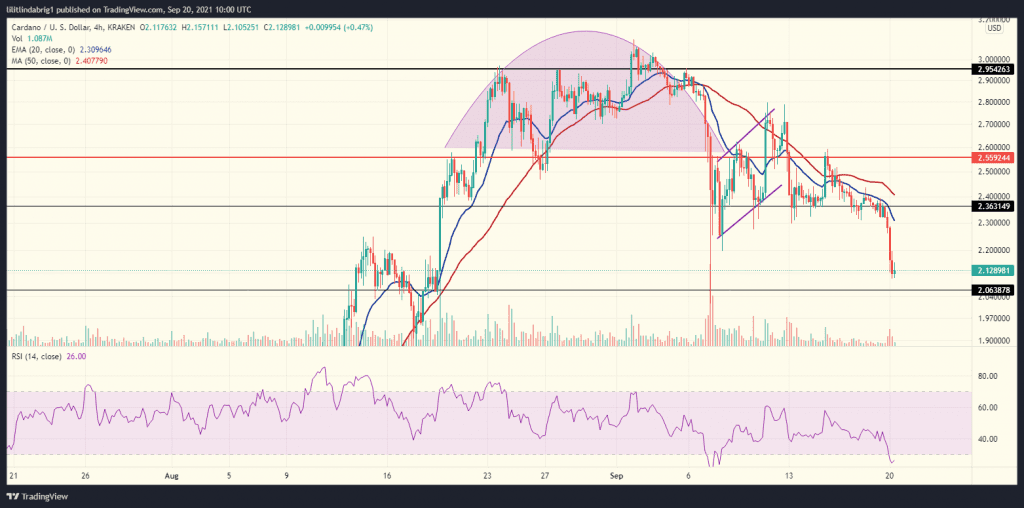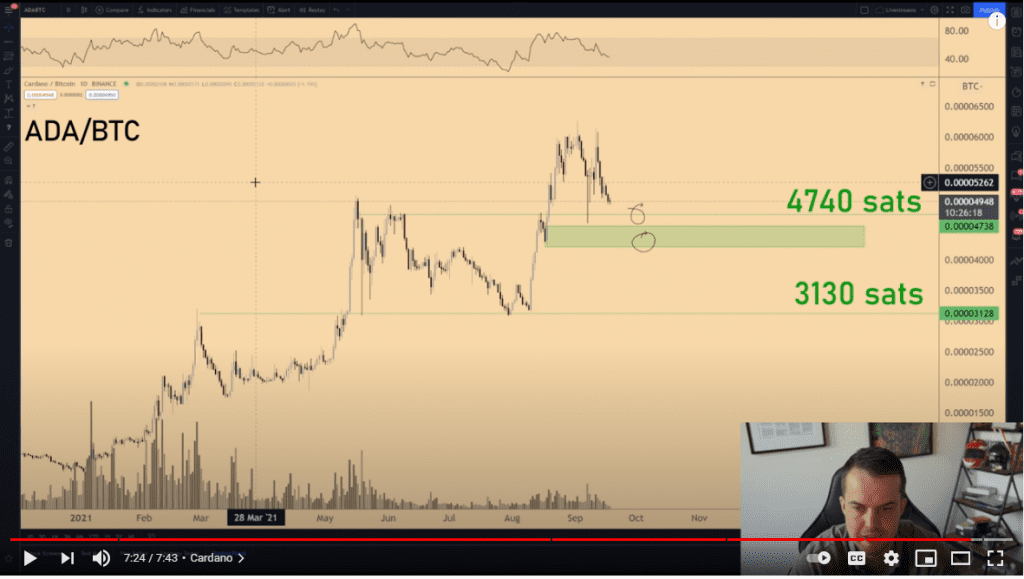
Key Takeaways:
- Cardano smart contracts employ a layer-2 protocol different to current soutions.
- The DeFi capabilities come at an innoportune time for the whole DeFi sector.
- ADA shows bearish signs, but the outcome could depend on the crypto market as a whole.
YEREVAN (CoinChapter.com) – Cardano, the open-source platform that recently (Sep. 12) launched smart contracts capability on its blockchain, declined 20 percent in the past week. Its native token ADA traded at 2.14 against the USD in the Monday session. The price surge that ADA bulls were hoping for is yet to come. However, the DeFi sector as a whole has seen a decline, as it is partially at fault for Cardano’s less-than-profitable debut.
Cardano smart contracts
The much-anticipated Alonzo rollout introduced Cardano to the DeFi sector that boomed since January 2021. However, with smart contracts comes the scalability issue that plagues large DeFi blockchains, like Ethereum. On Friday, Cardano already introduced Hydra, a layer-2 scaling solution designed to process payments off-chain.
Input-Output Hong Kong (IOHK, the development team behind Cardano) defined Hydra as a “fast, isomorphic state channel.” The team stated that the current layer-2 solutions’ contract code could not be reused off-chain without change.
Hydra simplifies offchain protocol and smart contract development by directly adopting the layer-one smart contract system, in this way allowing the same code to be used both on- and offchain
stated the IOHK team.
Moreover, Cardano claimed that Hydra could make transactions on the blockchain take less than one second to complete. Transaction speed and scalability are issues that all the major layer-1 platforms strive to solve. However, the DeFi sector as a whole has somewhat lost the momentum it put on in Q1 and Q2.
Also read: Cardano halts after smart contract launch, but ADA flashes bullish signs.
Declining DeFi segment?
In detail, Ethereum, as a pioneer in the smart contract sector, enjoys the biggest share of the DeFi market. On Sep. 5, at the peak of DeFi’s TVL data (total value locked), Ethereum controlled $139 billion, while the whole sector was worth $187 billion (roughly 74%). However, the DeFi TVL has slid south since then.
As of the moment, the total TVL stood at $169 billion, after declining by 4.7% in the past 24 hours alone. Ethereum has lost 16 percent of its total value locked since the September 5 peak, while Solana lost 26 percent since September 12.

Moreover, nosediving NFT (non-fungible token) sales were partially to blame for the DeFi decline. On Sep. 10, two days before Cardano smart contracts rollout with Alonzo fork, NFT sales plummeted 86 percent. However, the NFT market is getting back on its feet, as the data from Opensea indicates.
In hindsight, Opensea is the largest top NFT marketplace by sales volume. After the crash, Opensea saw an improvement in weekly sales and new users (up by 1 and 9%, respectively). The upcoming sessions will show if the recovering NFT market can help bring gains to the DeFi sector.
Also read: Ethereum-Solana bridge Wormhole v2 goes live as SOL and ETH fall over 10%
Meanwhile, ADA…
… dropped back 20 percent and hit a significant support line at $2.06. After the bearish price action, the 20-day exponential moving average (EMA-20) has corrected its trajectory and headed south, which could lead to a death cross. The latter is a bearish cross between a short-term MA and a long-term MA that signifies more losses ahead.
In addition, it looks like ADA could have played out the inverse cup and handle setup, which could lead to further bearish price action.
In hindsight, the inverse cup and handle formation consists of a large arch-like movement, followed by a small and sharp uptrend. After the uptrend, however, the pattern predicts a fall. As a result, ADA’s inverse cup was more visible on the 4-hour chart.

However, Michael Van de Poppe, an Amsterdam-based analyst with a vast following, saw a positive future for Cardano if ADA manages to hold on to the support level ahead.

Also read: Bitcoin whale accumulation heats up as BTC holds above $47K
Cardano flashed both positive and negative signs on the charts. However, the state of the DeFi market as a whole, Bitcoin’s price action, and the overall success of Hydra will determine if Cardano succeeds in the next quarter.


